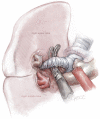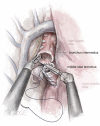Uniportal fully robotic-assisted major pulmonary resections
- PMID: 36793991
- PMCID: PMC9922773
- DOI: 10.21037/acs-2022-urats-29
Uniportal fully robotic-assisted major pulmonary resections
Abstract
Robotic-assisted thoracoscopic surgery (RATS) has proven advantages over that of conventional thoracic surgery, primarily by offering a three-dimensional view and excellent maneuverability, and by providing great ergonomic comfort to the surgeon. The instrumentation specifically offers seven degrees of freedom, allowing for safe, yet complex dissections and radical lymphadenectomies. However, the robotic platform was initially designed with four robotic arms in mind, and therefore four to five incisions were needed for most thoracic approaches. The uniportal video-assisted thoracoscopic surgery (UVATS) approach, the philosophical predecessor to the uniportal robotic-assisted thoracoscopic surgery (URATS) approach, evolved very quickly with the help of the latest technologies during the last decade. Since the first cases of UVATS in 2010, we have improved upon the technique, such that we are now able to do increasingly more complex cases. This is due to the acquired experience, specifically designed instruments, better high-definition cameras and more angulated staplers. In our efforts to improve and adapt robotic surgery to the uniportal approach, we utilized the initial available platforms (Davinci Si and X) to test the feasibility of this approach, in terms of safety and possibilities. The latest platform, the Da Vinci Xi, due to the configuration of its arms, did indeed allow for us to reduce the number of incisions to two initially and finally to one. We hence decided to fully adapt the Da Vinci Xi® to allow for the URATS approach routinely, and performed the first fully robotic anatomic resections in the world in September 2021, in Coruña, Spain. We define pure or fully robotic URATS as robotic thoracic surgery performed by a single intercostal incision, without rib spreading, using the robotic camera, robotic dissecting instruments and robotic staplers.
Keywords: URATS; URATS lobectomy; Uniportal RATS; robotic lobectomy; single port RATS.
2023 Annals of Cardiothoracic Surgery. All rights reserved.
Conflict of interest statement
Conflicts of Interest: The authors have no conflicts of interest to declare.
Figures












References
Publication types
LinkOut - more resources
Full Text Sources
